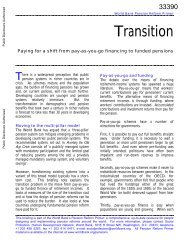Financial Sector Development in Africa: Opportunities ... - World Bank
Financial Sector Development in Africa: Opportunities ... - World Bank
Financial Sector Development in Africa: Opportunities ... - World Bank
You also want an ePaper? Increase the reach of your titles
YUMPU automatically turns print PDFs into web optimized ePapers that Google loves.
44 Porteous<br />
concentrated, successfully, on us<strong>in</strong>g the mobile as a specialist extension<br />
channel. We will discuss one of these—the First National <strong>Bank</strong> of South<br />
<strong>Africa</strong>—<strong>in</strong> the second section of this chapter.<br />
While first-generation players generally launched <strong>in</strong> developed- country<br />
environments with established f<strong>in</strong>ancial <strong>in</strong>frastructure, the <strong>in</strong>itial secondgeneration<br />
players launched <strong>in</strong> 2001 through 2002 <strong>in</strong> develop<strong>in</strong>g-country<br />
environments such as Zambia or the Philipp<strong>in</strong>es. They soon realized, if<br />
they had not before, that they could not assume that there were nearly<br />
enough locations at which customers could convert cash <strong>in</strong>to electronic<br />
value. Models that depended on bank branches alone simply could not<br />
make headway. The second-generation models are therefore dist<strong>in</strong>ct <strong>in</strong><br />
their focus of build<strong>in</strong>g a new physical channel of merchants or agents at<br />
which cash could be loaded or withdrawn. These models were designed<br />
with the assumption that most clients had a basic handset capable only of<br />
basic 2G data channels, which was the case for the overwhelm<strong>in</strong>g majority<br />
of people adopt<strong>in</strong>g mobile phones for the first time. A f<strong>in</strong>al dist<strong>in</strong>guish<strong>in</strong>g<br />
feature of the second generation is that the MNOs had been<br />
dom<strong>in</strong>ant players to date. We will argue that, <strong>in</strong> order to develop and<br />
protect their core voice bus<strong>in</strong>ess, MNOs had the strongest <strong>in</strong>centives and<br />
abilities to play—but we will also see that these very same motivations<br />
may limit the ultimate reach of this generation.<br />
The third generation of mobile f<strong>in</strong>ancial services started with the<br />
spread of handsets capable of Internet brows<strong>in</strong>g and runn<strong>in</strong>g Java-type<br />
applications. These capabilities do not require the expense of a “smartphone.”<br />
(Smart handsets are spread<strong>in</strong>g quickly but, because of a price tag<br />
of US$200 upward, are limited to the top end of the market <strong>in</strong> develop<strong>in</strong>g<br />
countries.) Third-generation services simply require an “enhanced”<br />
phone or “feature” phone that is Internet-capable: these are now available<br />
for as little as US$60 <strong>in</strong> some markets. For several years now, a greater<br />
number of enhanced handsets than basic handsets have been shipped to<br />
develop<strong>in</strong>g markets, as customers seek features such as e-mail and<br />
Internet access. While mobile Internet is <strong>in</strong> its <strong>in</strong>fancy worldwide, it is<br />
already show<strong>in</strong>g what <strong>in</strong>vestment analyst Morgan Stanley calls “unprecedented<br />
early stage growth.”<br />
<strong>Africa</strong> is no exception to the global trend. A major implication for<br />
f<strong>in</strong>ancial services is that specialist payment providers other than mobile<br />
operators may now more easily offer payment services, both as e- commerce<br />
transactions and person-to-person payments. A key difference from the<br />
second generation is therefore that the arrival of the Internet on the handset<br />
has <strong>in</strong> a sense thrown the door wide open to a new range of providers.







